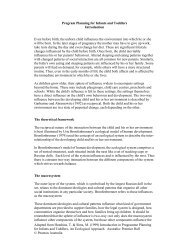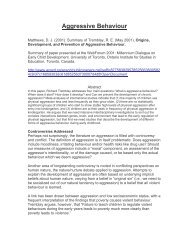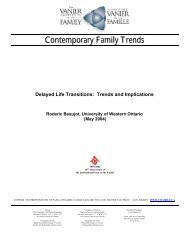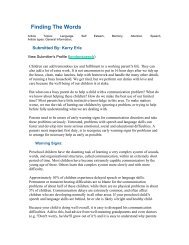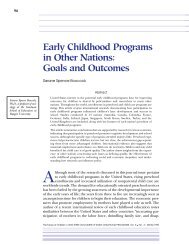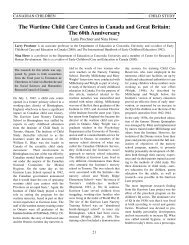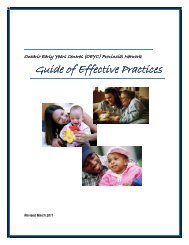Emotional Growth Through Musical Play - Peel Early Years
Emotional Growth Through Musical Play - Peel Early Years
Emotional Growth Through Musical Play - Peel Early Years
You also want an ePaper? Increase the reach of your titles
YUMPU automatically turns print PDFs into web optimized ePapers that Google loves.
<strong>Emotional</strong> <strong>Growth</strong> <strong>Through</strong> <strong>Musical</strong> <strong>Play</strong><br />
by Mary Stouffer<br />
Music is a wonderful art form that encompasses all areas of child development: physical, intellectual,<br />
social and emotional. From as early as four months, the fetus is able to hear outside musical stimuli.<br />
Whether the mother is listening to Mozart or Alannis Morisette, musical development has begun. This<br />
article focuses on emotional development through music for several reasons. Firstly, emotional<br />
development is a part of child development that generally does not attract much attention; it is a difficult<br />
area to study in babies but a crucial part of human development. Secondly, music is an art form that<br />
often communicates emotion. And thirdly, music is a natural medium for young children.<br />
Psychologists have long been aware that early communication between parent and child is extremely<br />
important in developing the child's capacity of communication and awareness of others. This<br />
encourages social behaviour and interest in other people. The lullaby is a parent's song of love, comfort<br />
and security. It is accompanied by the physical and emotional closeness between parent and baby, which<br />
are just as important as the tranquil melody. The mother holds the baby in her arms and commences to<br />
move in a soothing rocking motion. The physical contact between parent and baby, the stimulation of<br />
the ear, the creation of a positive emotional mood and the physical rocking motion stimulate many of<br />
the baby's senses and in turn, encourage brain development.<br />
Motivated to communicate by her mother's comforting voice, a baby responds by crying, cooing and<br />
babbling. Research shows that the more frequently a baby is sung to, the more utterances and verbal<br />
sounds she produces. The baby not only likes to be sung to, but is very interested in and enjoys her own<br />
vocalizing.<br />
The lullaby is a direct and powerful emotional catalyst for communication and bonding between parent<br />
and child. Its simple beauty and emotional context has even inspired great composers like Schubert and<br />
Brahms.<br />
Nursery rhymes, finger and toe plays and tickling games are the young child's musical repertoire. True<br />
children's games that evoke an emotional response are perfect examples of art in a child's world. Art<br />
involves tension and climax. A movement of a sonata by Beethoven has similar emotional development<br />
to a simple child's game. It has the same artistic structure and value as a true children's game: beginning<br />
-> tension builds -> climax -> resolution.<br />
Many of you know the following tickling game:<br />
Round and round the garden<br />
(Adult draws a circle on baby's palm.)<br />
Like a teddy bear,<br />
One step, two step<br />
(Adult walks two fingers up baby's arm.)<br />
Tickley under there!
(Adult tickles baby under the arm.)<br />
<strong>Through</strong> the game, the physical human contact between adult and child creates a close feeling.<br />
The touch, physical closeness and facial expressions exchanged between the adult and child are similar<br />
to the interaction when singing a lullaby. As the rhyme progresses and the adult's fingers "walk" up the<br />
child's arm, the child starts to feels the anticipation of the tickle and grows more excited. When the<br />
climax of the tickle is experienced, an emotional high occurs. Repetition of this short game initially<br />
helps the child to become involved and also helps to create a mood. When the game is repeated as many<br />
times as the child would like, the emotional response grows stronger each time. When the child has had<br />
enough, the games reaches an end and the child relaxes, reaching a point of satisfaction.<br />
Bouncing rhymes have a greater appeal for older babies. Being jostled on an adults lap is stimulating to<br />
the inner ear and the sense of balance and develops the child's sense of physicality.<br />
One, two, three,<br />
(Baby is facing adult, sitting on the lap. Adult bounces baby to the beat of the rhyme.)<br />
Baby's on my knee,<br />
Rooster crows,<br />
And away she goes!<br />
(Adult gently "drops" baby backwards through the legs.)<br />
This is a much more active game but the emotional climax will develop in a similar fashion to the<br />
tickling game. The beginning of the rhyme moves to the line of anticipation "Rooster crows", and<br />
climaxes with the drop "And away she goes!" The baby will experience a deep feeling of joy with the<br />
repetition of the game.<br />
Babies and young children are reliant on their caregivers to give them these playful and joyous<br />
experiences. <strong>Emotional</strong> development is far too important to leave to chance. Parents and caregivers need<br />
to access the most artistic rhymes and games in the folk repertoire, use their own voices and their own<br />
touch to give babies deep emotional experiences.<br />
Mary Stouffer is a faculty member at the Royal Conservatory of Music in Toronto where she teaches Music With Your Baby<br />
classes, music for preschoolers and Kodály classes. She is also involved in teacher training and is a part-time instructor at<br />
Ryerson Polytechnic University. Mary is currently completing her M.Mus. in Education with Kodály Emphasis from the<br />
University of Calgary.<br />
This article was published by the<br />
Canadian Child Care Federation.<br />
Posted by the Canadian Child Care<br />
Federation.



